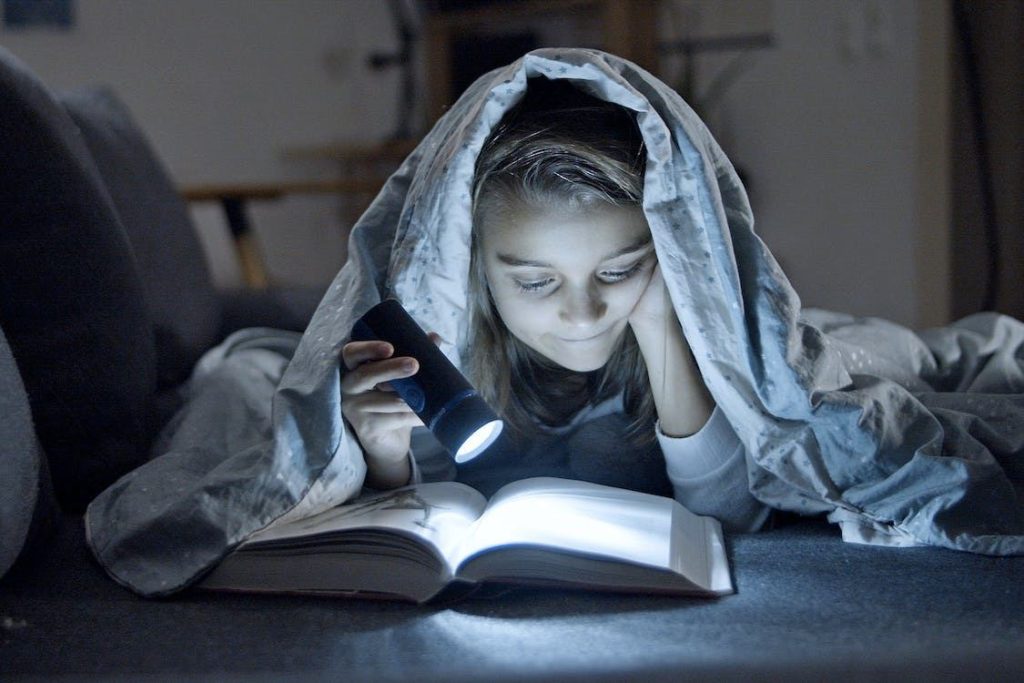We decided to investigate whether reading in the dark without light or with a flashlight under a blanket harms the eyes, a common belief that many parents have instilled in their children since childhood.
To gain insight into whether reading in low light poses a threat to the eyes, it’s crucial to comprehend how this organ operates under varying light conditions. An object’s elementary particles of light, also known as photons, are reflected and enter the retina’s light-sensitive cells. They then transmit an electrical impulse signal to the brain via a chain of neurons. If the lighting is insufficient, the pupil dilates to allow more light to enter the retina, while if there’s too much light, the pupil contracts, regulating the photon flow that reaches the light-sensitive area of the eye. The body automatically performs this pupillary response, making it impossible to forget to adapt the pupil to the modified level of light. When transitioning from low lighting to bright, the pupil shrinks to the necessary size within a few seconds. Conversely, when moving back to darkness, the pupil’s response is slower. In typical lighting conditions, the pupil’s diameter is about 3 mm. It increases to 3.8 mm in the first second after darkening, followed by an additional 2 mm after five seconds. The adaptation process takes up to 15 minutes, during which the pupil reaches a diameter of 7.4-8 mm. Unlike bright light, darkness can’t cause traumatic changes.
The dilator pupillae muscle and the sphincter pupillae muscle control the pupil’s dilation and contraction, respectively. The sphincter muscle swiftly contracts when there’s a sudden flash, safeguarding the eye, but some light-sensitive cells remain inactive for a while. If the light abruptly turns on in a dark room, dark spots may float before the eyes, and the individual may experience unpleasant, painful sensations. In contrast, if the light suddenly turns off in a bright room, the light-sensitive cells slowly adapt to the darkness, and the person won’t feel any discomfort.
Nonetheless, everyday experiences suggest that the eyes shouldn’t undergo additional stress in low lighting. When people feel eye strain, they usually move away from bright light and rest their eyes in semi-darkness. Weak lighting mildly irritates the retina’s light-sensitive cells, and dimmer light allows the eyes to relax.
Experts concur that dim lighting is not detrimental to the eyes. Andrey Sazonov, a physician and advocate of evidence-based medicine, notes that lighting can be sufficient or insufficient. He suggests that any lighting that enables reading and writing is deemed suitable. He also draws an intriguing analogy, stating that claiming reading in low light is harmful to the eyes is akin to saying that listening to soft music harms hearing. Other experts express comparable views. American ophthalmologist Richard Rosen labels this belief as a myth and likens the lens system in our eyes to a camera, explaining that taking pictures in low light doesn’t harm the camera. Likewise, specialists from Harvard Medical School assert that this is a myth. Essentially, there’s no such thing as “insufficient” lighting for reading. If there isn’t enough light, the eye can’t distinguish letters. Conversely, if the eye can recognize letters, there’s enough light for reading.
Doctors acknowledge that focusing on text can be more challenging in dim lighting. Lower lighting intensity can reduce reading speed and comfort, as stated by experts. Dr. Rosen highlights that with bright lighting, there is a greater depth of field, allowing us to perceive finer details. Ophthalmologists also caution that reading in low light may cause eye fatigue to set in more rapidly, and for certain individuals, this strain may even trigger headaches. As a result, it is critical to be aware of one’s sensations and, if discomfort arises, to adjust the light’s brightness or postpone reading until a more appropriate setting is available.
Regulatory lighting standards are established by law for workplaces of various professionals and educational institutions. These standards indicate the optimal lighting intensity for effective learning or work without causing excessive strain on the eyes. However, the legal document does not specify that decreasing this standard will result in harm to the eyes.
In conclusion, reading in low light does not harm vision as commonly believed. It is important to rely on subjective sensations and rest the eyes when feeling tired. However, reading under covers with a flashlight cannot be considered safe, as it can lead to problems due to the small distance between the eyes and the book. The optimal distance between the face and the book is 35-40 cm, which is difficult to achieve while covered with a blanket and shining a flashlight on oneself.
Related posts:
- Does Looking at Someone You Love Really Cause Your Pupils to Dilate?
- The Pros and Cons of Dark Mode for the Eyes and Health
- What exactly is a Complete Blood Count (CBC) lab test?
- Examining 15 Popular Supplements: Determining the Most Beneficial Amino Acids for Athletes
- Unlocking the Potential of Umbilical Cord Blood Stem Cells
- Tips for safeguarding your skin against sun damage

Responses